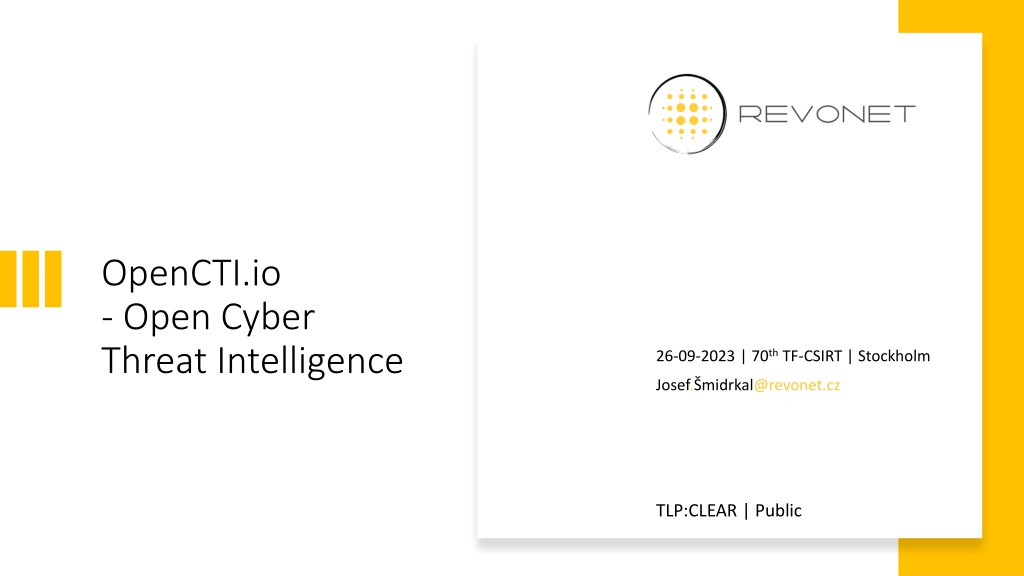

Replay
0 likes | 20 Views
OpenCTI is an open-source platform developed for handling cyber threats, incident response, and collaborative work. It offers dynamic intelligence feeds, automated workflows, and integration with IT systems. Security analysts can visualize and analyze relationships between entities, import/export STIX data, and utilize pre-built connectors for enhanced threat intelligence. With the ability to cooperate with MISP, TheHive/IRIS, IntelOwl, YETI, and commercial TI providers, OpenCTI provides a comprehensive solution for threat analysis and management.

E N D
OpenCTI.io - Open Cyber Threat Intelligence 26-09-2023 | 70thTF-CSIRT | Stockholm Josef.Šmidrkal@revonet.cz TLP:CLEAR | Public
What? Open Threat Intelligence Platform Store, organize, visualize and share knowledge about cyber threats. Handle incident response cases and collaborative work. Developed by French National Agency for the Security of Information System (ANSSI) and non-profit organization Luatix (defunct) (now developed by Filigran.io) https://opencti.io
Why? Dynamic intelligence feed • OpenCTI displays operational and strategic information linked through a unified data model based on STIX2 standards. • Automated workflows: Its engine arrives at logical inferences automatically to deliver insights and real-time correlations. • Integration with the IT ecosystem: Its open- source architecture enables easy integration with all homegrown and third-party systems. • Smart data visualization: Analysts can visualize entities and their relationships, including nested relationships, with multiple view options. • Analysis tools: All information and indicators are linked to a primary source to drive analysis, scoring, and remediation. • Free & Open Source (and actually useful) • Easy to deploy (somewhat) • Integrates well with other tools (somewhat) • Security Analysts Workbench + Case Management • STIX import & export • OpenCTI Community Edition: Apache License 2.0 • OpenCTI Enterprise Edition: OpenCTI Non-Commercial License (shameless copy & paste: spiceworks.com)
Q&A: We use MISP • “Malware Information Sharing Platform” is more a “backend” for storing, categorizing and sharing IoCs. • Why not to use both? OpenCTI can ingest MISP events and enrich them with additional threat intelligence (-> see IoCs in TI context). • Your Threat Hunter & Security Analyst can cooperate in OpenCTI while keeping your MISP instance ‘ballast-free’... https://github.com/OpenCTI- Platform/connectors/blob/master/external-import/misp/README.md https://www.cosive.com/misp-vs-opencti (no to ‘versus’ approach)
Q&A: We use TheHive/IRIS for Case Mgmt • Depends on your usage scenario, why not to use both? • OpenCTI for your Analysts, potentially better (visualization) for management reporting. • IRIS: https://dfir-iris.org/ (by Airbus Security), gaining popularity after https://thehive-project.org/ license change
Q&A: We use IntelOwl for auto-intel • OpenCTI and IntelOwl complement each other and can work well together https://intelowl.readthedocs.io/en/latest/Usage.html#connectors List of pre-built Connectors: • MISP: automatically creates an event on your MISP instance, linking the successful analysis on IntelOwl. • OpenCTI: automatically creates an observable and a linked report on your OpenCTI instance, linking the successful analysis on IntelOwl. • YETI: YETI = Your Everyday Threat Intelligence. find or create observable on YETI, linking the successful analysis on IntelOwl.
Q&A: We use YETI • OpenCTI and YETI are comparable with each having its benefits. • YETI = “…platform meant to organize IOCs and observables” • Why not to use both? https://yeti-platform.github.io/ Maltego has transforms for both YETI and OpenCTI
Q&A: We use commercial TI provider XY • Ready-made external-import connectors for TI feed providers like • Intel471 • Crowdstrike • Eset • Flashpoint • Kaspersky • Recorded Future • Do not ingest TI provider feed into your SIEM directly!!! (unless it’s custom-made for you) • Do not ingest TI provider STIX feed into your MISP directly! (analyze it first in OpenCTI and export to MISP what’s useful) • https://github.com/OpenCTI-Platform/connectors/tree/master/external-import
Q&A: Not easy to deploy/maintain Can be deployed using Docker together with: • Wazzuh • IntelOwl • MISP • etc. Instance to generate (some) screenshots for this presentation deployed today on my laptop during morning talks. (Demo?)
• Medium.com: OpenCTI platform intro • https://demo.opencti.io/dashboard • https://training.filigran.io/ • YouTube: Introduction to the OpenCTI platform • TryHackMe.com: OpenCTI room (subscribers only) -> prepared and configured instance, used within guided case investigation Learning / Training / Resources
Thank you https://github.com/smidrkal/OpenCTI (License: Unlicense = do as you like) Try it yourself in Docker!